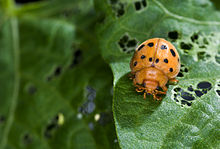Epilachninae
| Epilachninae | |
|---|---|
 |
|
| Epilachna varivestis, the Mexican bean beetle | |
| Scientific classification | |
| Kingdom: | Animalia |
| Phylum: | Arthropoda |
| Class: | Insecta |
| Order: | Coleoptera |
| Family: | Coccinellidae |
| Subfamily: |
Epilachninae Mulsant, 1846 |
The Epilachninae are a subfamily of the family of ladybugs, the Coccinellidae, in the order Coleoptera. Superficially, they look much like other ladybirds in the larger subfamily Coccinellinae, but they differ importantly in their biology, in that the members of the subfamily are largely or completely leaf-feeding herbivores rather than being predators. Accordingly, several members of the subfamily are crop pests, and sometimes cause locally serious crop losses.
The Epilachninae constitute about 16% of the described species of the Coccinellidae. Their identification is no problem in the field when examining routine crop damage, because they are selective feeders, but a specimen obtained out of context can be troublesome; their markings are not consistent, so offhand identification is unreliable. For reliable identification, one may have recourse to dissection to inspect the genitalia, or may inspect the eggs and larvae, which often are more distinctive than the adults.
The taxonomy of the Epilachnini is currently under investigation, and while little disagreement exists about their status as members of the Coccinellidae, various authors are discrepant in their assignment of genera. While over a dozen genera have been described in this tribe alone, the current trend is to recognise just two, or perhaps three genera, into which other genera have been merged. For instance, Solanophila is now included in Epilachna. As is at present the case with many taxa, the outcome is dependent on nucleic acid studies. For the present, the two genera Epilachna and Henosepilachna are clearly established as probably constituting a monophyletic group, but the genus Subcoccinella seems not to belong in the Epilachninae at all. Subcoccinella had been included in the Epilachnini on the grounds of morphology, in particular the herbivorous mouthparts, but the resemblance now seems to have arisen by adaptation to plant feeding.
The Epilachninae are most notorious as pests of crops in the families Solanaceae and Cucurbitaceae, but as a group they feed on a much wider range of plants. However, most species in the subfamily are monophagous, each feeding on just one species of plant, or at most a narrow range of closely related species. Among the crop plants they attack are grains such as maize, and legumes such as beans, including soya. Others attack spinach, and yet others feed on Brassicaceae and cotton.
...
Wikipedia
